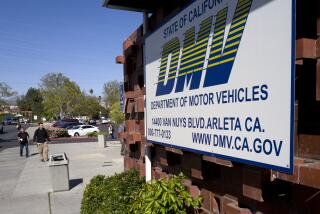Should cyclists need a license to ride?
- Share via
Bicyclists remind drivers all the time that they have as much right to be on the road as car drivers. OK, so should they be licensed like drivers are? We hear that from our commenters on the Roadshare page. I hear it from friends who, driving, get exasperated by bicyclists they see flouting the rules of the road, going through stop signs and traffic lights or swerving harrowingly close to cars. (“And the three-foot rule applies to you,” grumbles a pickup-driving friend, riffing on what he would tell a bicyclist. “Stay away from me while I’m in my truck — at least three feet.”)
We’re not talking about licensing bicycles. The state of California allows municipalities to choose to opt into a program to license bikes. The city of Los Angeles did for a while but opted out. There was very little compliance and, as Michelle Mowery, the L.A. Department of Transportation senior bicycle coordinator says, the city didn’t have the resources to maintain a database of bicycles and owners. It wasn’t a revenue producer — each new registration certificate could cost no more than $4 — and there is already a national bike registry that is useful to join in case your bicycle is stolen.
But could we see cyclists going to the DMV, taking a road test and a written test, being handed a license to carry on themselves at all times on a bike?
PHOTOS: Cycling the mean streets of Hollywood
“Good idea to do training. Bad idea to do licensing,” says Colin Bogart, director of education for the Los Angeles County Bicycle Coalition. “First, we need to understand why people are licensed to drive — you’re behind the wheel of a potentially dangerous vehicle. The same is not true for bicyclists. You’re not getting behind the wheel of a two-ton vehicle that can go as fast as 60 miles an hour. The bicyclist is potentially a danger to a pedestrian, but mostly they are a danger to themselves if they don’t follow the rules.”
But what about the cyclist whose bad behavior in traffic forces cars into a precarious situation on the road? License or no license, the cyclist is supposed to be obeying traffic laws. “If a cyclist does something they’re not supposed to and a cop is there, they get busted too,” says Bogart.
Besides, at what age do you start licensing cyclists, he asks. “Does that mean kids who want to ride a bike?”
FULL COVERAGE: Sharing the road in L.A.
Maybe, I say — if they want to ride in street traffic.
Bogart says drivers calling for cyclists to be licensed is more a perception issue. “Bicyclists were given the right to ride in the street long before cars were,” he says, referring to the 1880s and 1890s. “The perception is that the road is just for drivers.”
Licensing is less the concern than education. Mowery doesn’t have any problem with cyclists getting licensed “as long as the state DMV were to create a program to educate cyclists and provide rules in a handbook.”
She says the L.A. Department of Transportation is looking for funding to do a bicycle education program in high schools.
At one point, the Bicycle Coalition offered a series of classes, underwritten by Metro funding, to teach adult cyclists. The coalition puts out a guide to rules of the road on its website. “Basically we tell cyclists that 50% of the crashes between bicyclists and drivers are cyclists’ faults and 50% are drivers’ faults.”
If you are interested in taking a cycling education class, Mowery notes that the League of American Bicyclists holds good classes. Check them out on their website.
There’s plenty that the average driver and recreational bicyclist may not know. For example: A cyclist does have the right to take up an entire car lane in the street — if the lane is too narrow for a car and bike to share and if there is no dedicated bike lane. Bicyclists — and drivers — often assume that cyclists should always ride as far to the right in a lane of traffic as possible. That’s fine — unless the car you’re to the right of might be on its way to making a right turn at the next corner. “We teach cyclists to pass on the left,” said Bogart. Nor does the DMV do a great job educating drivers on how to drive safely around cyclists, he says.
“If everybody as part of growing up learned the rules of the road for driving and bicycling, they would be better drivers and better cyclists,” he says.
It’s unlikely licensing bicyclists would bring about any great détente in traffic between drivers and cyclists. But would it make cyclists more mindful of the rules of the road? Does licensing drivers make them more obedient about the rules of the road? Not often enough.
ALSO:
The right way to make a federal budget
Nov. 22, 1963: 50 years, and still no conspiracy
This post is part of an ongoing conversation to explore how the city’s cyclists, drivers and pedestrians share and compete for road space, and to consider policy choices that keep people safe and traffic flowing. For more: latimes.com/roadshare and #roadshareLA.
More to Read
A cure for the common opinion
Get thought-provoking perspectives with our weekly newsletter.
You may occasionally receive promotional content from the Los Angeles Times.











